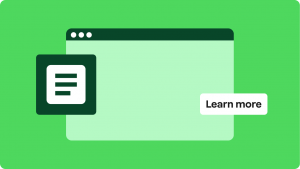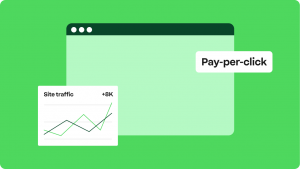Key takeaways:
- Online businesses are booming, and this growth offers major opportunities for new entrepreneurs.
- Four major areas will see massive growth in 2025: online shopping, virtual education, digital content creation, and independent contracting. Use these trends to determine where to focus your efforts on.
- You have various online business options to explore, from selling products in your own online store to offering specialized services as a freelancer. Pick an idea that matches your skills and interests, and then get started building your online venture.
Have you noticed that almost everyone you know turns to the internet for their retail needs? At the rate it’s going, Statista forecasts that the U.S. online shopping revenue will reach USD$1.8 trillion by 2029.
This comes as no surprise since online transactions offer benefits like convenience, special deals, and extensive product options.
If you’re considering starting an online business, this article will first talk about online business trends in 2025. Then, we’ll explore the 25 best online business ideas for next year and focus on how you can earn from each one.
Online business trends in 2025
2025 is set to be a year of significant growth for the online business world. As consumers grow more enticed to purchase goods or services on the internet, several industries have successfully adapted to this transition.
eCommerce
eCommerce has become one of the fastest-growing sectors in the online industry. In fact, the International Trade Administration projects global eCommerce sales to reach USD$5.5 trillion by 2027.
This growth is driven by various factors like Artificial Intelligence (AI) and global reach.
Advancements in AI and automation help businesses streamline their operations. From handling larger volumes of orders to offering personalized shopping experiences, these technologies are helping companies save time and cut costs while boosting profits.
Also, the ability to reach a worldwide audience offers endless sales opportunities as opposed to being limited to a physical store.
Online education and e-learning
The virtual learning industry is also experiencing rapid growth, as Statista predicts a global market volume of USD$279.30 billion by 2029. This type of learning is becoming more popular among students because of its several benefits.
Remote learning allows individuals to access educational content anywhere in the world. It also enables them to customize their courses and learn them at their own pace.
Due to its virtual nature, students don’t need to commute to class or spend money on physical learning materials. Online businesses offering educational courses and tutoring services will greatly benefit from this expanding market.
Digital content creation and streaming
These days, the demand for digital media continues to rise, and different elements play critical roles in this increase.
Internet accessibility reached new heights in February 2025, with approximately 5.56 billion users worldwide, according to Statista. Additionally, the widespread use of smart devices has made digital content more accessible and convenient.
Consumers are also developing a preference for on-demand content, as more people choose streaming services over traditional media. This surge presents a promising future for online businesses in:
- Content creation
- Podcasting
- Monetization across platforms
Independent contracting
Digital platforms being accessible has made it easier for independent contractors to connect with clients globally. This technology provides seamless collaboration, which enables them to offer services like:
- Digital marketing
- Social media consulting
- Content writing
Beyond that, businesses turn to freelancers to acquire specialized skills without needing to hire them full-time. This approach offers flexibility and cost savings that let companies scale their workforce based on project needs.
These aspects directly influence the expansion of the independent contracting industry. In fact, according to a recent forecast by Statista, freelancers are predicted to comprise 50.9% of the U.S. workforce by 2027.
25 best online business ideas for 2025
As technology continues to evolve rapidly, aspiring business owners can find many opportunities to build a business online. Here are some of them:
eCommerce and retail businesses
- Online store
- Dropshipping business
- Subscription box service
- Print-on-demand (POD) service
- Clothing line
- Handcrafted goods
- Digital products
Content and media creation businesses
- Online course creation
- Affiliate marketing
- YouTube channel or video content creation
- Blogging
- Podcasting
- Self-publishing
- Influencer marketing
Service-based businesses
- Freelance writing
- Virtual assistant (VA) service
- Social media consulting
- Digital marketing agency
- Online fitness training service
- Bookkeeping or accounting
- Voice acting
- Web development
- App development
- Language translation service
Other online business ideas
- Website flipping
Let’s get into more detail on each online business idea.
eCommerce and retail businesses
1. Online store
With an online store, you can sell items to consumers directly through an eCommerce website. These products include:
- Physical goods
- Handmade items
- Digital products like eBooks or software
The store operates 24/7, so customers can make purchases at any time, from anywhere. With the right tools, you can manage orders, shipping, and customer inquiries all from one platform.
How you can profit
You can generate profit by selling your products at a higher price than it costs to produce or source them. Your margins will depend on:
- Product costs
- Shipping fees
- Other operational expenses, like website hosting or marketing
Finding the right mix between price and demand for your products while keeping your costs low is important for making money with your online store.
How to get started
- Find a specific niche and create a strong brand identity around it.
- Create high-quality product images and compelling descriptions that highlight benefits in addition to features.
- Regularly analyze your sales data to understand popular products and optimize your inventory.
- Provide excellent customer service, including clear shipping policies and easy returns, to build trust and encourage repeat business.
- Engage with your customers through social platforms to foster a community around your brand.
Tools
To make your online store, consider user-friendly platforms like Network Solutions. We offer an AI builder, website security services, and online marketing tools. All of which help you build and maintain your eCommerce store.
You can also use Canva to design attractive logos and marketing materials, even without design experience. For inventory management and order fulfillment, find tools that integrate seamlessly with your chosen platform.
These can be AI-driven demand forecasting tools that optimize stock levels and prevent overselling or dead stock.
Read our articles related to building an online store for your business:
- Top Benefits of an Online Store Every Business Should Know
- How an eCommerce Chatbot Can Improve Your Online Store
2. Dropshipping business
In the dropshipping business, you don’t need to hold any inventory or store products. Instead, you act as a middleman who lists items from suppliers in your online store.
It works like this: once a customer purchases an item, the supplier ships the product directly to them. This setup lets you focus on areas like customer service while the supplier manages inventory and fulfillment.
It’s a low-risk way to sell products without the overhead of storing goods or managing logistics.
How you can profit
You can profit from the difference between the price you set and the wholesale cost from the supplier. Since you’re not paying for stock upfront, your initial costs are low, which makes it a great business model for beginners.
To increase profits, you can experiment with product pricing and find high-demand items that can be marked up effectively.
How to get started
- Look for in-demand products that solve a problem or cater to a specific interest.
- Research thoroughly potential suppliers to ensure they:
- Are reliable
- Offer good quality products
- Have efficient shipping times
- Build a strong brand around your dropshipping store through unique marketing and excellent customer communication to stand out from competitors.
Tools
Platforms like BigCommerce are ideal for setting up a dropshipping store. Meanwhile, apps like DSers or Printify can connect you directly with suppliers and automate order fulfillment.
Leverage research tools to spot popular items and niches. You can try:
- AliShark
- Google Trends
- Semrush
Additionally, use social media advertising through platforms like Facebook and TikTok. Consider building an email list with ConvertKit or MailerLite to engage with potential customers.
Read our article about the best dropshipping products in 2025 to help you plan your dropshipping business.
3. Subscription box service
This service is usually a monthly subscription where customers receive a customized package of items related to a specific category. These can include:
- Beauty products
- Snacks
- Fitness gear
- Fashion
- Pet care
Each box is designed to fit the preferences of the target audience, which creates an element of surprise with each delivery.
How you can profit
You can profit from the subscription fees and the difference between what it costs to source and package the products.
As you scale, bulk ordering from suppliers can reduce product costs and allow you to increase your margins. If you want to increase your profits, you can also offer premium subscription tiers or exclusive items.
How to get started
- Pinpoint a niche with a passionate audience. Think beyond general categories; for example, instead of just “coffee,” consider “ethically sourced single-origin coffee for adventurous drinkers.”
- Research your competitors to identify gaps you can fill or ways to differentiate your offering. You can try:
- Unique and personalized themes
- Exclusive products
- A strong brand story
- Source quality products for your prototype box and determine a pricing model that covers the following:
- Product costs
- Packaging
- Shipping
- A healthy profit margin
- Partner with reliable suppliers for your products and consider third-party logistics (3PL) providers for fulfillment and shipping as your business grows.
- Build anticipation with a pre-launch email list and social media campaign where you show sneak peeks of your box.
Tools
For platform and operational support, use eCommerce solutions designed for subscriptions. Try Cratejoy or Subbly, which handle recurring billing and customer management.
Other tools you can use are:
- Canva for designing attractive box inserts and marketing materials
- ConvertKit for nurturing leads
- Buffer for promoting your box and engaging with your target audience
4. Print-on-demand (POD) service
Print on demand means you’ll only print and ship products, like custom mugs or t-shirts, as your customers order. You’ll also work with a print-on-demand (POD) service provider that will handle the following for you:
- Production
- Inventory
- Shipping logistics
How you can profit
You make a profit from the difference between the cost of producing the item and the price you charge the consumer.
Since there are no upfront inventory costs, this online business keeps your initial investment low. It also gives you more room to be creative and produce appealing designs to increase your sales.
How to get started
- Conduct market research on trending designs and popular product categories to identify opportunities.
- Partner with a reliable POD service provider.
- Create a strong brand identity through your designs and marketing efforts to stand out in the competitive POD market.
Tools
Printful and Printify are two of the most popular print-on-demand platforms. They provide a wide range of products and integrations with eCommerce platforms.
Both provide mockup generators, which help you visualize your designs on products and create professional-looking product images for your online store.
5. Clothing line

Launching an online clothing line involves designing, manufacturing, and marketing your unique apparel. You curate everything from the fabric choices to the final product’s aesthetic and branding.
How you can profit
You can sell your garments directly to consumers through your own eCommerce website and social media platforms. You can also explore wholesale opportunities with boutiques or online retailers.
Profitability comes from strategies that encourage repeat purchases and customer loyalty. These tactics include:
- Effective pricing
- Managing production costs
- Building a strong brand
How to get started
- Determine your niche market and design a cohesive collection that appeals to them.
- Source ethical and high-quality materials, and then find reliable manufacturers. Consider print-on-demand services for a lower initial investment.
- Showcase your products through enticing and engaging photos.
- Make your own online store for your designs.
Tools
For design, you can use software like Adobe Illustrator or Photoshop. As for sourcing and manufacturing, research local manufacturers or use platforms like Alibaba for international options.
Platforms like Network Solutions are user-friendly options for building your online store. We also offer SEO and business directory services to market your eCommerce site.
6. Handcrafted goods
Selling handcrafted goods means creating unique items by hand and selling them to customers. This can include:
- Jewelry
- Ceramics
- Custom artwork
- Knitted goods
This online business idea allows you to turn a hobby or creative skill into a profitable venture, right from the comfort of your home.
How you can profit
Sell your handcrafted items online through your own website or established marketplaces. You can also use courier services to consign your items to boutiques.
It’s important to price your items appropriately to cover material costs and your labor. Remember to also build a loyal customer base who appreciates unique, handmade quality.
How to get started
- Define your product niche and develop a consistent style for your goods.
- Source high-quality materials and hone your crafting skills.
- Build a strong brand identity, including a memorable name and logo.
- Take excellent product photos that highlight your craftsmanship, and then choose the best online platforms to showcase and sell your items.
Tools
Platforms like Etsy are excellent for reaching a wide audience interested in handmade items. You can also consider setting up your own eCommerce store.
For product photography, a good camera (even a smartphone with good lighting) and basic editing software are important.
A social media presence, particularly on Instagram and Pinterest, is valuable for showcasing your creations and engaging with customers.
7. Digital products
Selling digital goods is one of the most profitable online business ideas that requires a low investment. Since these products are electronic, you can sell an unlimited number of copies without shipping costs and without running out of inventory.
You can sell digital products like:
- eBooks
- Design templates
- Software
- Online courses
- Music
- Custom digital art
How you can profit
Digital products offer high-profit margins because they don’t require production or shipping costs. After the initial investment of time and effort to create the product, every sale is almost pure profit.
You can also bundle digital products or offer premium versions to increase your earnings.
How to get started
- Identify a problem or need your target audience has and create a digital solution.
- Focus on delivering tangible value that helps people either save time or learn a new skill.
- Promote your products through content marketing on your blog or social media, and consider offering a free sample. Here’s a guide on eCommerce content marketing that can help you make promotional content.
Tools
Platforms like Gumroad or Etsy offer straightforward ways to sell online, especially for beginners.
You can also leverage the tools below for designing your digital products and publishing eBooks:
- Canva
- Adobe Illustrator
- Amazon Kindle Direct Publishing (KDP)
Content and media creation businesses
8. Online course creation
Online course creation lets you share your knowledge with others while earning money. You can develop educational content in the form of:
- Video lessons
- Tutorials
- Written materials
Then, you sell these courses on online platforms where students can enroll and access them at their own pace. This is a great way to teach skills you’re passionate about, which can be:
- Coding
- Copywriting
- Photography
- Social media management
- Graphic designing
How you can profit
Your course sales make up your profit. This means that the more students enroll, the higher the income you earn. Generally, pricing for online courses depends on the depth and value of the content. It can range between $20 and several hundred dollars.
You can also offer bundles or certifications to increase sales. Plus, you can create multiple courses over time, which enables you to generate a steady stream of income.
How to get started
- Identify a specific skill or knowledge area where you have expertise and that also has market demand.
- Research what potential students want to learn by exploring online communities and forums and conducting surveys.
- Structure your course content logically, breaking it down into manageable modules with clear learning objectives.
- Focus on delivering engaging content through a mix of:
- Video
- Text
- Interactive elements
- Promote your course on platforms where it’s guaranteed to reach your target audience.
Tools
Platforms like Kajabi and Teachable provide all-in-one solutions and built-in marketing features. You can host, sell, and deliver your online courses in one place.
For creating engaging video content, consider user-friendly video editing software like DaVinci Resolve or Camtasia. Meanwhile, Canva can help you design appealing course thumbnails and promotional graphics.
To enhance engagement, incorporate interactive elements using quiz builders or survey tools.
9. Affiliate marketing
Affiliate marketing is a great online business idea where you advertise other companies’ products or services through unique affiliate links.
Affiliate marketers earn a commission through consumer clicks and purchases tied any of the links. The right approach is to recommend products that fit your audience’s interests to drive sales easily.
Additionally, a notable advantage to affiliate marketing is that you don’t need to handle inventory or customer service. You’ll only need to connect customers with products that satisfy their needs.
How you can profit
Your earnings depend on how much traffic you drive to your affiliate links. The more clicks and conversions you generate, the more you earn.
Commissions vary by product and affiliate programs. If you prefer larger payouts, you can go for high-ticket items or recurring subscription services.
How to get started
- Choose a niche you’re genuinely passionate about and knowledgeable in, as this authenticity will resonate with your audience.
- Create high-quality, valuable content that genuinely helps your audience make informed decisions. Try making:
- Reviews
- Tutorials
- Comparison guides
- Post your content across various channels to reach a broader audience. Upload them to your:
- Blog site
- YouTube channel
- Other social platforms
- Join reputable affiliate networks like Awin or ShareASale, which connect you with a wide range of brands and products.
Tools
Use Google Analytics 4 for website analytics and understanding your audience’s behavior. For developing search engine optimization (SEO) strategies, leverage tools like Ahrefs or Semrush.
If you’re considering joining Amazon’s Associates program, read our article about creating your Amazon Affiliate website.
10. YouTube channel or video content creation

Creating a YouTube channel requires you to produce video content around a specific niche. You can attract viewers by uploading:
- Tutorials
- Product reviews
- Vlogs
- Entertainment
Then, once you’ve built an audience, you can monetize your content. Basically, you’ll earn more opportunities as you gain more engagement on your videos.
How you can profit
YouTubers typically earn money from the YouTube Partner Program. In this program, creators earn a portion of the money made from the ads that appear on their videos.
Additionally, you can make money off of brand sponsorships by featuring or mentioning their products in your videos. Eventually, successful creators find other streams of income, such as selling custom merchandise to their viewers.
How to get started
- Pick a niche you can consistently create content around.
- Research successful channels in your chosen niche to understand what resonates with viewers.
- Focus on providing value and high-quality production, even with basic equipment.
- Upload videos consistently and engage with your audience in the comments section. This will help you create a community within your channel.
- Use YouTube’s analytics to understand your audience and content performance.
- Share your videos on other social platforms and work with other creators to expand your reach.
Tools
For video creation, which involves shooting and editing footage, opt for the tools below:
- A good camera
- A microphone for clear audio
- Adequate lighting
- Adobe Premiere Pro for editing
For channel growth, tools like TubeBuddy or VidIQ help optimize your videos for search. They offer insights into:
- Keywords
- Tags
- Competitor analysis
11. Blogging
Blogging is creating valuable and engaging content that entices readers to keep visiting your website. You can center your blog around several topics like:
- Self-help
- Mental health
- Food
- Finance
Then, when you establish a consistent following, you can monetize your content through various channels.
How you can profit
Bloggers generate earnings through affiliate commissions. This is when readers click on affiliate links in your blog posts and make purchases afterward.
Another method to gain profit from blogging is to work with ad networks that pay you based on the number of visitors and ad clicks on your blog. Lastly, you can get paid to write sponsored content for brands about their products and services.
How to get started
- Select a topic you’re genuinely interested in. Something you can consistently create in-depth, helpful content about.
- Research your topic thoroughly and organize the ideas you’re considering to include in your post.
- As you start writing, aim to solve specific problems or answer common questions for your target readers.
- After publishing your first blog, it’s time to plan and schedule your next posts. Ensure to maintain a consistent posting schedule.
- Engage with your audience in the comments section to build a loyal community.
Tools
Consider platforms like WordPress.com. It’s an ideal choice for beginner bloggers, as WordPress.com handles the technical aspects of building and maintaining a website. Check out our article about getting started with WordPress.
Other tools you can use are:
- Grammarly for ensuring your writing is polished and professional
- Semrush for finding good keywords and optimizing your blog site for search engines
- Canva for design eye-catching visuals for your posts and social media promotion

12. Podcasting
If you prefer this type of business model, your job will involve creating audio content about certain topics. With podcasting, you’ll record regular episodes that are shared with listeners through platforms like Spotify or Apple Podcasts.
Podcasts are popular because they allow creators to connect with their audience in a personal and engaging way.
How you can profit
Podcasts generate income from a variety of sources. As your audience grows eventually, you can monetize your podcast through:
- Sponsorships
- Ad placements
- Listener donations
Businesses pay you to promote their goods or services in your episodes through sponsorships. Additionally, ad placements help you generate revenue based on the clicks or desired actions tied to the ad you display on your content.
Some podcasters also rely on listener donations via platforms like Patreon, or they sell merchandise related to their show.
How to get started
- Identify a unique angle that sets your podcast apart.
- Plan your first few episodes, outlining topics and potential guests, to ensure a smooth launch.
- Establish and maintain a regular posting schedule, whether it’s weekly or bi-weekly.
- Promote your podcast across social media, your website, and by guesting on other podcasts in your niche to expand your reach.
Tools
To record high-quality audio and edit engaging footage, invest in the following:
- An excellent microphone, like the Rode NT-USB
- An audio recorder and editor, like Audacity
You’ll also need a podcast hosting service like Buzzsprout to store your audio files and distribute your show to major podcast directories like Apple Podcasts and Spotify.
13. Self-publishing
Self-publishing enables authors to publish their books independently without going through traditional publishing houses.
This means you control the entire process, from writing and editing to formatting and marketing. You retain full creative control and a larger share of the royalties.
How you can profit
Sell your books on various online platforms and earn royalties directly from each sale. Authors can publish in different formats, such as:
- eBooks
- Print-on-demand paperbacks
- Audiobooks
To succeed with this online business, you need to:
- Consistently produce quality content
- Build an author brand
- Actively market your books to a targeted readership
How to get started
- Write a compelling book that will resonate with your target audience.
- Hire a professional editor and create a captivating cover design.
- Format your manuscript for digital and print platforms.
- Choose a self-publishing platform like Amazon Kindle Direct Publishing (KDP) or IngramSpark
- Upload your book, set your price, and then market your book through:
- Social media
- Author websites
- Email lists
Tools
For writing and editing, use tools like:
- Microsoft Word
- Google Docs
- Grammarly
- ProWritingAid
For cover design, you can use Canva for basic designs or hire a professional graphic designer.
14. Influencer marketing
Consider becoming an influencer and promote products or services to your audience. Influencer marketing involves:
- Building a considerable following on platforms like Instagram or TikTok
- Creating engaging content and sharing authentic experiences with viewers
- Acting as a brand ambassador for long-term campaigns
How you can profit
You can profit from brand deals. As an influencer, you become a trusted voice for your followers, and brands pay you to leverage that trust to reach their target customers.
With this online business, authenticity is important. Your audience needs to believe you genuinely use and endorse what you promote.
How to get started
- Choose a niche you’re passionate about and have expertise in. It can be:
- Sustainable fashion
- Gaming
- Healthy cooking
- DIY home improvement
- Make high-quality, engaging content that resonates with your chosen audience on social platforms.
- Build genuine connections with your followers by interacting with their comments and messages.
- Once you have a decent following and engagement, start researching brands that align with your content and audience.
- Reach out to them directly with a professional media kit with the following:
- Audience demographics
- Engagement rates
- Previous content examples
Tools
Consider tools like social media analytics within each platform, such as:
- Instagram Insights
- TikTok Analytics
- YouTube Analytics
They will help you understand your audience and content performance.
As for discovering brands and managing collaborations, try platforms like:
- GRIN
- Impact.com
- CreatorIQ
Lastly, for content creation and management, use:
- Canva
- Later
- Hootsuite
Service-based businesses
15. Freelance writing

Freelance writing involves offering writing services to businesses and individuals. This includes creating different types of content, like the following:
- Website copy
- Blog posts
- Marketing materials
As a freelance writer, you work on a project-by-project basis and help companies create engaging and effective content. You can specialize in a particular niche, such as:
- Tech
- Finance
- Lifestyle
- Health
- Fashion
Apart from that, you can also offer general writing services across multiple industries.
How you can profit
Freelance writers typically charge per project, per word, or by the hour. The rates you set vary based on your experience in the field and the complexity of the work.
Newer writers start with lower rates, but experienced writers can charge premium prices. With regular clients and high-quality work, freelance writing can become a steady and reliable income stream.
How to get started
- Define your niche or areas of expertise. Are you good at writing blog posts, or do you specialize in technical writing?
- Build a strong portfolio with high-quality writing samples that showcase your abilities and style.
- Pitch clients and focus on how your writing can meet their content needs.
- Continuously hone your writing skills and adapt to evolving content trends.
- Register on platforms like Upwork or Fiverr to help you find initial clients and build a reputation. However, also actively seek out direct clients through professional networking on LinkedIn or by reaching out to businesses in your chosen niche.
Tools
Leverage these tools for your freelance writing business:
- Grammarly for proofreading and improving readability
- Google Docs for collaborative writing and document management
- Trello or Asana to organize your writing tasks and deadlines effectively
16. Virtual assistant (VA) service
Virtual assistants (VAs) provide remote support to businesses or entrepreneurs. You’ll handle tasks like:
- Managing emails
- Scheduling meetings
- Conducting research
- Managing social media accounts
Since everything is done online, you can help clients streamline their operations and focus on more high-level tasks from anywhere in the world.
How you can profit
Virtual assistant services are usually charged by the hour. However, some VAs offer monthly packages depending on the services they provide. Like freelance writing, rates can vary widely, with more specialized services requiring higher fees.
How to get started
- Identify your core skills and choose a niche. Specializing early can help you stand out.
- Create clear service packages with transparent pricing, whether hourly, project-based, or a retainer.
- Build a website or online portfolio to highlight your skills and testimonials.
- Network online through platforms like LinkedIn and relevant Facebook groups to find your first clients. And don’t hesitate to offer a small introductory package to build trust and gather initial reviews.
Tools
Manage your VA business with communication and project management tools, such as:
- Slack
- Microsoft Teams
- Trello
- Asana
As for scheduling, consider tools like Calendly or Acuity Scheduling to automate appointments. And consider using time-tracking tools like Toggl if you plan to charge hourly. This provides transparency to your clients.
17. Social media consulting
As a social media consultant, your goals include:
- Developing and executing techniques that help companies connect with their customers
- Helping them create engaging content and manage marketing campaigns
- Guiding clients in researching trends and using paid ads effectively
How you can profit
Social media consultants generally charge either per project or on a monthly basis. You can base your rates on:
- The complexity of the work
- The platforms involved
- The company’s goals
Research in-demand industries and use the most effective platforms so you can set higher rates.
How to get started
- Master a few major social media platforms where your target clients are active.
- Focus on understanding algorithm changes and best practices for content creation and audience engagement.
- Build your own strong social media presence to demonstrate your expertise and attract potential clients.
- Create a portfolio of your successful social media projects, even if they’re personal accounts or pro bono work for friends’ businesses.
- Offer specialized services for a specific industry to position yourself as an expert. These services can be:
- Content creation
- Community management
- Paid advertising
Tools
To streamline your work, invest in social media management tools like Sprout Social or Hootsuite. These platforms allow you to:
- Schedule posts
- Monitor analytics
- Engage with followers efficiently
For content creation, try Canva for graphics or CapCut for video editing. These will help you produce professional-looking content quickly.
In addition, leverage analytics features within the social media platforms to track performance and demonstrate results to your clients. You can start with Facebook and Instagram Insights.
18. Digital marketing agency
Digital marketing involves helping businesses grow their digital presence through different tactics. These include:
- Content marketing
- Online advertising
- SEO
You’ll create and implement strategies tailored to each client’s goals, such as driving more traffic to their website or improving conversion rates. Your agency can manage all aspects of a client’s digital marketing, from campaign creation to performance analysis.
How you can profit
You earn profit by charging clients on a monthly basis or project basis. The fees depend on the scope of services you provide and the size of the client’s business.
Consider offering a specific and comprehensive package of services. This way, as you gain more customers, your revenue grows along with the demand for more specialized services.
How to get started
- Define your agency’s niche. Will you specialize in a particular service, like local SEO for small businesses, or cater to a specific industry? This focus helps you attract ideal clients and build specialized expertise.
- Develop your service offerings based on your skills and market demand.
- Build a website for your agency and maintain a strong social media presence.
- Write case studies and highlight testimonials from early clients to build credibility.
Tools
Consider the following tools to help build your digital marketing agency:
- Ahrefs for keyword research and competitor analysis
- Google Search Console for tracking website performance and user behavior
- ClickUp or Monday.com for project management
- Google Workspace for facilitating smooth collaboration with your team and clients
19. Online fitness training service
As an online fitness trainer, you offer remote services that will allow you to cater to a global clientele. Take note that this business requires you to have certifications in fitness and a strong understanding of health principles.
You can offer various services, such as:
- Personalized coaching and fitness plans
- Group classes
- Pre-recorded workout programs
Focus on areas like:
- Weight loss
- Strength training
- Yoga
- High-Intensity Interval Training (HIIT)
- Marathon training
How you can profit
Your income comes from:
- Direct client fees
- Subscriptions to your programs
- Digital products like downloadable meal plans or eBooks
How to get started
- Identify your niche. Consider the examples below:
- Strength training for busy professionals
- Yoga for beginners
- Marathon preparation for advanced levels
- Obtain relevant certifications from recognized organizations like:
- American Council on Exercise (ACE)
- National Academy of Sports Medicine (NASM)
- American College of Sports Medicine (ACSM)
- Create a professional business website with engaging social media profiles where you share:
- Blogs about health and fitness
- Client success stories
- Your expertise
- Offer various service packages to cater to different client needs and budgets.
Tools
Leverage platforms that will help you manage client programs and facilitate communication. Try using:
- Trainerize
- My PT Hub
- TrueCoach
Use Zoom or Google Meet for live sessions. As for creating and selling digital products, consider Teachable or Thinkific.
20. Bookkeeping or accounting

Starting an online bookkeeping or accounting business means you manage financial records for businesses and individuals from your home. You handle tasks like:
- Recording and categorizing business-related transactions
- Preparing financial statements
- Managing and processing payroll
- Managing business bank accounts
- Filing taxes
You’ll need a strong grasp of financial principles and accounting software.
How you can profit
You can profit from providing financial services to:
- Small businesses
- Freelancers
- Working professionals
Your main target market can be small businesses. These companies lack the resources for an in-house accounting staff but still need professional help to manage their finances.
How to get started
- Get relevant certifications like a Certified Public Accountant (CPA) license or a Certified Bookkeeper (CB) designation.
- Build a CPA website and define your service offerings and pricing structure there. Emphasize the benefits of outsourcing bookkeeping, such as cost savings and increased accuracy.
- Develop a marketing strategy targeted at small entities who need reliable financial support, like:
- Small businesses
- Startups
- Solo entrepreneurs
- Build a network and ask for referrals to help you find potential clients.
Tools
Online bookkeeping and accounting require cloud-based accounting software, like:
- QuickBooks Online
- Xero
- FreshBooks
These platforms let you access client financial data securely from anywhere.
Additionally, consider using client portals or secure file-sharing services for secure document sharing and client communication. You can also leverage project management tools like Asana or Trello to keep track of client tasks and deadlines.
21. Voice acting
In online voice acting, you use your voice to bring characters or scripts to life for various media. You’ll need the following:
- A clear speaking voice
- Good and versatile vocal control
- A home studio setup
This online business idea suits you if you have a versatile voice and enjoy performing.
How you can profit
You can profit from online voice acting by lending your voice to a variety of projects, including:
- Commercials
- Audiobooks
- E-learning modules
- Video games
- Animations
- Corporate narrations
You can charge per project, per word, or per finished hour of audio.
The rising consumption of digital content has created a massive demand for professional voice talent. With technology today, voice actors can work from their home studios and connect with clients globally.
How to get started
- Develop your voice acting skills by taking classes and workshops. Work with a voice coach to refine your:
- Delivery
- Character work
- Microphone technique
- Invest in quality recording equipment, including:
- A dynamic microphone
- A high-quality audio interface
- A quiet recording space
- Make a professional demo reel that showcases your vocal range and versatility across different genres.
- Market yourself on online casting platforms like:
- Voices.com
- Voice123
- Audiobook Creation Exchange (ACX)
- Build a personal website to highlight your demos and services.
- Network on professional voice acting forums and social media groups to gain valuable connections and insights.
Tools
For microphones, consider high-quality equipment like Rode NT1-A or Audio-Technica AT2035. As for audio interfaces, try using Focusrite Scarlett 2i2 or other similar devices.
Consider software like Audacity and Adobe Audition for recording and editing. Lastly, use a pop filter and acoustic treatment for your recording space to ensure clean audio.
22. Web development
Web development involves creating and maintaining websites. These can include simple static pages or complex web applications with databases and user interaction. Web developers focus on various areas of a website to ensure it’s appealing and practical.
These aspects include the following:
- Design
- Functionality
- Overall user experience
How you can profit
You can offer services to small businesses, startups, and even established companies. Charge per project or on a retainer basis for ongoing maintenance.
Include developing different kinds of websites in your services, like:
- eCommerce stores
- Portfolio websites
- Blog sites
How to get started
- Determine a niche within web development that interests you. Are you drawn to building websites for local restaurants or creating custom WordPress themes?
- Learn foundational languages like HyperText Markup Language (HTML), Cascading Style Sheets (CSS), and JavaScript.
- Practice by building personal projects or revamping existing, poorly designed websites.
- Build a portfolio for your skills and start networking to find your first clients.
Tools
Beginners can use free online courses from platforms like Codecademy or freeCodeCamp to learn coding basics.
For website building, explore content management systems (CMS) like WordPress, which offers many free themes and plugins. On the other hand, consider frameworks like React or Angular for more complex projects.
23. App development
Developing apps involves creating software applications for mobile devices or desktop computers. This includes:
- Designing the user interface
- Coding the logic
- Ensuring the app’s smooth performance
App developers address specific user needs, whether it’s for entertainment, productivity, or business operations.
How you can profit
Create and sell your apps directly to users through app stores or offer your development services to clients. Many businesses seek custom apps to:
- Enhance their operations
- Engage customers
- Provide unique services
You can profit from:
- App sales
- In-app purchase
- Subscriptions
- Advertising within your free apps
How to get started
- Identify a problem you can solve or a niche you can serve with an app.
- Learn a programming language relevant to your target platform, such as Swift for iOS and Kotlin or Java for Android.
- Build small, simple apps to understand the development process.
- Once you have a polished app or a strong portfolio, market your services or launch your app on their respective app stores.
Tools
For learning, use resources like Apple’s Developer documentation for Swift and iOS. As for Android, the Android Developers’ official guides are excellent starting points.
Beyond that, leverage Xcode for iOS and Android Studio for Android for the app development process.
24. Language translation service
A language translator converts text or audio from one language into another and ensures the meaning, context, and tone remain accurate.
This work bridges communication gaps between people who speak different languages. Basically, you help diverse individuals and businesses understand each other seamlessly.
How you can profit
Businesses frequently need translations for various channels and content to reach global audiences. These include:
- Websites
- Marketing materials
- Legal documents
Some clients require translations for personal documents like:
- Birth certificates
- Academic transcripts
- Immigration papers
The more proficient you become in specialized fields like medical or legal translation, the more you can earn.
How to get started
- Determine your strongest language pairs and any specialized niches you can serve.
- Make your own website or a professional profile on freelance platforms.
- Showcase your expertise, provide samples of your work, and gather testimonials from early clients.
- Connect with other professionals and market your services to potential clients who need language support.
Tools
For tools and resources, start with reliable translation memory software like SDL Trados Studio or memoQ. These will help you maintain consistency and speed.
You can also use online dictionaries and glossaries for accuracy. Add to that, find online courses and tutorials to refine your translation skills and learn about business practices in the industry.
Other online business ideas
25. Website flipping
Website flipping is when you buy underperforming sites, improve their traffic and value, and then sell them for a higher price.
How you can profit
You earn revenue from the difference between the cost of buying the website and the amount you sell it for. You’ll have to make sure that you significantly improve the site’s traffic and overall performance to gain higher resale value.
How to get started
- Research websites for sale that have potential for growth but are currently undervalued. Look for sites with existing traffic or a solid backlink profile that you can optimize.
- Evaluate your chosen website using tools like Google Analytics to verify traffic data and Ahrefs to analyze its backlink profile and keyword rankings.
- Implement strategies to improve it in different areas, such as:
- Content
- User experience
- Search engine rankings
- Once you’ve grown the site, prepare the data showcasing its performance and profit potential to attract potential buyers.
Tools
Go to platforms where you can find websites for sale. Popular marketplaces include:
- Flippa
- Empire Flippers
- Acquire.com
How to know which online business idea is perfect for you
Figuring out which online business is best for you requires discernment and market research. You’ll also need ample planning time, as your choice will determine the trajectory of your venture.
Check out these four factors to help you know which online business is ideal for you:
- Skills and strengths
- Market demand
- Startup costs and resources
- Long-term goals and lifestyle
Here’s a breakdown of each factor to consider when brainstorming online business ideas.
Skills and strengths
Evaluate what you’re good at. The most successful businesses often align with the owner’s expertise or strengths. For instance, a graphic design agency might be a natural fit if you’re skilled in design.
Matching your business with your strengths gives you a competitive edge and boosts your confidence.
Market demand
A profitable business idea needs to solve a real problem or meet a demand in the market. Look into what people need or want, especially in your field of interest.
For example, if you notice a growing trend in health and wellness, a related service or product might be a profitable choice. Research current trends by using tools like Google Trends or industry reports.
Additionally, keep an eye on consumer behavior to ensure your idea aligns with what people are actively looking for.
Startup costs and resources
Consider the resources you have and what each business type will require to get off the ground. Some businesses, like freelance services, need minimal upfront investment. Meanwhile, others might require more capital for inventory or storage.
Understand the financial commitment before diving in and look for ways to leverage your current resources effectively. This will keep your finances healthy and help you avoid unnecessary stress.
Long-term goals and lifestyle
Finally, think about what kind of lifestyle you want and how each business idea fits with it. If you’re looking for flexibility and independence, a freelance or consulting role is ideal. If you prefer a fixed schedule, a local retail store might work.
Consider how the business will impact your personal life and if it supports your vision for the future. Aligning your business with your lifestyle goals makes it more sustainable and enjoyable.
Launch your online business today
There are many options for online businesses that you can start today. All you have to do now is ask yourself which one fits your skills, financial situation, and future goals.
Through this guide, you’ve discovered that eCommerce, virtual learning, digital media, and independent contracting are the leading online industries today. AI and the accessibility of digital platforms have helped these sectors grow exponentially over time.
Now that you’ve learned about 25 online business ideas that are guaranteed to thrive in 2025, we hope this article helps you with your venture.
Whether you’re considering dropshipping or affiliate marketing, build your own business today and launch it online! Start with a reliable online store builder to bring your online business to new heights.
Frequently asked questions
For beginners, great online business ideas include dropshipping, where you sell products without holding inventory, or print-on-demand services, which let you create custom designs for various items.
Creating and selling online courses is another idea you can try. These options generally have lower startup costs and a simpler entry point.
Several online business trends are currently growing, including eCommerce and online education services.
Also, live commerce (livestream shopping) and authentic, personalized marketing are gaining traction. These enable businesses to connect more directly with their audience.
Future-proof online business models are often customer-centric and adaptive to new technologies. Models that embrace Artificial Intelligence (AI), focus on building strong digital presences, and offer diversified revenue streams tend to be resilient.
Online businesses that generate passive income often involve creating a product or asset once and earning from it repeatedly with minimal ongoing effort.
Examples include:
Selling digital products
Affiliate marketing
Blogging
Uploading YouTube videos
You can do service-based businesses from home. Consider offering language translator services or freelance writing. These businesses only require mobile devices like laptops, an internet connection, and messaging platforms.
Additionally, eCommerce businesses, like dropshipping and print-on-demand services, let you sell products online without needing a physical store.
Selling digital products is highly profitable since it requires a low upfront investment but is highly scalable. You’ll only need to create items once, and then you can sell them repeatedly. Digital goods include:
Online courses
eBooks
Custom digital art
Software




